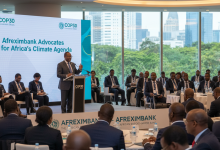How mmWave Improves Internet Access in Africa

mmWave technology is reshaping internet access in Africa by delivering ultra-fast speeds and addressing connectivity challenges in both urban and rural areas. It operates in the 30–300 GHz range, offering data rates over 1 Gbps. This makes it ideal for high-demand applications like telemedicine, education, and smart city systems.
Key Points:
- Urban Areas: Solves network congestion in cities like Lagos and Nairobi, offering high-capacity connectivity.
- Rural Areas: Provides wireless solutions where fiber installation is costly or impractical.
- Affordability: Reduces infrastructure costs compared to traditional broadband.
- Challenges: Requires dense base stations, struggles with tropical weather, and faces regulatory hurdles.
- Economic Impact: A 10% increase in broadband penetration can boost GDP by up to 1.38%.
While mmWave faces deployment challenges, hybrid models combining satellite and wireless systems show promise for extending high-speed internet across underserved regions. Investments and policy reforms are key to scaling its benefits.
Smarter Beams, Not Bigger Bills: 26 GHz mmWave Wi-Fi in Plain English
How mmWave Technology Improves Broadband Access
mmWave technology is changing the game for internet connectivity in Africa. By offering incredible speeds, flexible deployment options, and advanced capabilities, it addresses the continent’s unique challenges with infrastructure. Unlike traditional broadband solutions that often falter in Africa’s varied terrains, mmWave provides practical ways to close the digital divide, making it a key player in transforming connectivity across the region.
High-Speed and Low-Latency Connectivity
With speeds exceeding 1 Gbps, mmWave technology is dramatically faster than the sub-6 GHz bands that most African networks currently use. This isn’t just a theoretical advantage – real-world deployments are already proving its effectiveness across the continent.
What makes mmWave even more valuable is its low latency, which is crucial for time-sensitive applications. This technology supports telemedicine, interactive e-learning, and real-time agricultural tools, directly addressing the needs of African communities. For example, small businesses can now use high-quality video conferencing and cloud-based services to expand their reach, creating economic opportunities in rural areas and reducing the need for urban migration.
Additionally, mmWave’s speed and capacity enable bandwidth-heavy applications like augmented reality, autonomous vehicles, and smart city systems. These advancements allow African communities to bypass older development stages and adopt cutting-edge technologies, fueling economic growth and innovation.
Affordable Deployment Options
One of the biggest hurdles for traditional fiber-optic infrastructure in Africa is the continent’s vast and varied landscapes. Installing cables across such terrains is often impractical and extremely expensive. mmWave technology sidesteps these issues by delivering gigabit speeds wirelessly, significantly lowering infrastructure costs.
Innovative satellite systems further reduce the expense of connecting remote areas. Combined with fixed wireless access (FWA), mmWave provides a cost-effective solution, especially in regions where fiber installation isn’t feasible. The African Union High Level Panel on Emerging Technologies has even highlighted FWA and satellite technologies as essential tools for bridging the digital divide in underserved areas.
This wireless approach allows for rapid deployment without the need for extensive ground infrastructure. Operators can profitably extend connectivity to remote regions, creating sustainable solutions that benefit both service providers and local communities.
Support for New Technologies
The benefits of mmWave go beyond affordability – it also serves as a launchpad for cutting-edge applications. Its high capacity and reliability make it ideal for supporting smart city initiatives, IoT, cloud-based services, and fintech, all of which are driving digital transformation across Africa.
Healthcare is another area poised for transformation. Beyond basic telemedicine, mmWave enables advanced applications like remote surgery assistance, real-time medical imaging, and AI-powered diagnostics. These tools can bridge the gap between rural clinics and specialist expertise in urban centers, addressing critical healthcare challenges.
To fully unlock mmWave’s potential, the African Union’s High Level Panel on Emerging Technologies recommends allocating 400 MHz to 1 GHz of contiguous spectrum in high bands for optimal 5G services. This allocation ensures that African countries can leverage mmWave to support advanced technologies and foster inclusive development across underserved regions. By powering next-generation applications, mmWave technology not only modernizes infrastructure but also opens the door to meaningful progress for communities across the continent.
Challenges in Deploying mmWave Technology in Africa
mmWave technology holds promise for improving internet access across Africa, but its implementation faces significant hurdles. These challenges arise from the continent’s varied geography, climate, and regulatory environment, all of which complicate efforts to establish reliable networks. Addressing these issues requires tailored approaches to ensure mmWave’s potential can be realized in both urban and rural areas.
Infrastructure and Terrain Challenges
Africa’s diverse and expansive terrain poses significant difficulties for deploying mmWave networks. The high costs and logistical challenges of laying fiber optic cables in remote areas – an essential step for supporting mmWave base stations – are major barriers. In regions with low population density, the limited revenue potential further discourages investment in such infrastructure. Compounding the issue, many countries in Africa lack the foundational connectivity needed to support advanced mmWave systems, forcing operators to make substantial investments in basic infrastructure.
For example, the African Development Bank provided a $160 million loan to Axian Telecom in January 2025 to expand 4G and 5G technologies across nine African nations. However, mmWave’s short range necessitates a dense network of base stations, making deployment in rural or rugged areas prohibitively expensive. Consequently, mmWave networks are often concentrated in high-density urban hubs like Johannesburg, Lagos, Nairobi, and Cairo, leaving large rural regions without access to this technology.
Weather and Technical Limitations
Africa’s tropical climate presents additional challenges for mmWave technology. High humidity, heavy rainfall, and atmospheric moisture in regions like Nigeria significantly affect signal performance. These conditions increase signal absorption at mmWave frequencies (30–300 GHz), which diminishes both range and strength. Moreover, mmWave signals have a shorter range and are more easily obstructed compared to the sub‑6 GHz frequencies used in traditional 5G networks. Combined with Africa’s varied terrain and dense vegetation, these factors lead to frequent coverage gaps that require advanced, adaptive solutions.
Weather-related signal degradation also raises the cost and complexity of deploying mmWave networks. To overcome these obstacles, operators need to invest in infrastructure designed to withstand high humidity and intense rainfall.
Policy and Regulatory Considerations
Regulatory inconsistencies across Africa further complicate mmWave deployment. Many countries have unpredictable regulatory environments, making it challenging for operators to plan long-term investments. The African Union’s High Level Panel on Emerging Technologies has identified several shortcomings in current frameworks, such as the lack of standardized procedures for securing wayleave and right-of-way approvals – both critical for installing the dense network of base stations required for mmWave.
To address spectrum allocation issues, the panel suggests that African nations assign minimum contiguous spectrum blocks of 80–100 MHz in mid-bands and 400 MHz to 1 GHz in high bands. Additionally, defragmenting prime bands could improve bandwidth efficiency and data transmission.
Another regulatory challenge comes from competition with satellite providers. Local telecom operators often feel threatened by international satellite companies, leading to actions like blocking or seizing unauthorized Starlink equipment in some countries. To create a more stable investment environment, the African Union recommends establishing clear and consistent frameworks for infrastructure deployment, regulation, and management. These measures would help standardize approval processes and provide the predictability needed for long-term projects.
Tackling these regulatory hurdles is essential for extending mmWave’s benefits to underserved communities. With effective policy reforms, the path to broader adoption of mmWave technology becomes more achievable.
sbb-itb-dd089af
Economic and Social Benefits of mmWave-Enabled Broadband
While deploying mmWave technology comes with its challenges, the rewards it offers – both economically and socially – are undeniable. High-speed connectivity powered by mmWave opens doors to growth, education, and digital inclusion, transforming communities across Africa.
Connecting Underserved Communities
mmWave broadband is a game changer for rural areas, connecting them to essential services. With speeds reaching up to 100 Mbps, this technology supports initiatives like telemedicine, which reduces the need for patients to travel long distances for healthcare.
This connectivity directly addresses Africa’s digital divide, building on earlier innovations in infrastructure. It also dramatically expands educational opportunities. Students in remote areas can access e-learning platforms and high-quality resources previously limited to urban centers. Beyond education, reliable internet enables remote work, giving people in rural areas the chance to participate in the global economy.
The economic impact is clear: research shows that a 10% increase in broadband penetration can lead to GDP growth of up to 1.38% in developing nations.
Supporting Local Business and Startups
For local businesses, mmWave internet is a catalyst for growth. Small enterprises can establish an online presence, while startups gain access to high-speed, low-latency connectivity for cloud tools, enabling them to compete on a global scale.
This reliable connectivity strengthens the digital economy. Businesses can adopt modern practices, implement digital payment systems, and integrate into global supply chains. These advancements attract foreign investment and equip local entrepreneurs with digital skills and virtual networking opportunities. Together, these changes drive community-wide transformation, as seen in real-world examples.
Case Studies and Examples
Real-world implementations showcase the transformative power of mmWave technology across Africa. Early trials demonstrate its ability to deliver ultra-fast broadband in urban areas, enabling smart city solutions and advanced business services.
Investments across the continent highlight confidence in mmWave’s potential. These initiatives aim to connect millions in underserved and rural areas, fueling economic growth and promoting digital inclusion.
Nigeria, for instance, has become a hub for mmWave pilot projects, focusing on enterprise connectivity and mobile network densification. In another example, Eutelsat partnered with Orange Africa in March 2025 to provide broadband access in Côte d’Ivoire, Senegal, and the Democratic Republic of Congo through a hybrid model combining satellite and terrestrial networks.
These examples underline the strategy to bridge Africa’s digital divide using mmWave technology. As Tech In Africa reports, such advancements are vital for closing the gap and driving sustainable economic growth across the continent.
The early success stories from mmWave deployments offer a clear path forward, proving that the benefits of this technology outweigh the challenges of implementation. They provide a blueprint for scaling up efforts to connect more communities and foster long-term development.
Pros and Cons of mmWave Technology
Understanding the strengths and weaknesses of mmWave technology is essential for making informed decisions about broadband deployment in Africa. This perspective helps us explore how mmWave could play a role in bridging the continent’s digital divide. While the technology holds immense promise, it also comes with unique challenges that need to be addressed.
Benefits of mmWave in Africa
mmWave technology brings several advantages that make it appealing for African markets. One of its standout features is the ability to enable faster deployment in areas with difficult terrain, compared to traditional infrastructure. It also excels in handling high-capacity networks, especially in densely populated urban centers, making it ideal for applications like telemedicine and online education that demand low latency and high reliability.
Another major benefit is its cost-effectiveness for last-mile connectivity. Since mmWave requires less physical infrastructure, ongoing maintenance costs are lower, which leads to quicker returns on investment. This makes it a practical choice for telecom providers operating in cost-conscious markets.
Drawbacks of mmWave Technology
Despite its benefits, mmWave technology faces some notable challenges in the African context. One of the primary limitations is its short range. mmWave signals weaken quickly and require a clear line of sight, which means base stations need to be placed much closer together than in traditional networks. This increases the complexity and cost of deployment.
Weather conditions also pose significant obstacles. mmWave is highly sensitive to atmospheric factors like heavy rain and high humidity, which are common in tropical climates. These conditions can weaken signals and reduce reliability, complicating network planning.
Another hurdle is the high upfront investment required. While operational costs may be lower compared to fiber, the specialized equipment and dense network infrastructure needed for mmWave demand substantial initial capital. Additionally, regulatory challenges, such as fragmented spectrum allocation and inconsistent approval processes, further slow down deployment efforts.
| Advantages | Disadvantages |
|---|---|
| Quick deployment in tough terrains | Limited range (requires line-of-sight) |
| Low latency for critical applications | Weather sensitivity (rain, humidity) |
| Ideal for dense urban areas | High initial investment costs |
| Affordable last-mile connectivity | Regulatory and policy challenges |
Tackling these challenges is critical to unlocking the full potential of mmWave technology.
Ways to Maximize Impact
To address these limitations and amplify the benefits of mmWave, several strategies can be employed. One promising approach is hybrid deployment. By combining mmWave with sub-6 GHz, fiber, and satellite technologies, operators can extend high-speed connectivity while minimizing issues related to range and terrain.
Investing in weather-resistant infrastructure is another key step. Adaptive technologies and specially designed equipment can help maintain signal quality in tropical climates. For example, advanced antenna systems and signal processing techniques tailored to local conditions can significantly improve performance during adverse weather.
Localized research and development are also vital. Collaborations between international tech companies and local institutions can create solutions tailored to Africa’s unique environmental and economic conditions. This approach can help reduce costs while addressing specific challenges.
Policy reforms can further accelerate deployment. Simplifying regulatory frameworks, streamlining approval processes, and standardizing spectrum allocation can lower barriers for telecom providers. Governments can also support deployment through public-private partnerships that share the financial and operational risks of building the necessary infrastructure.
Lastly, shared network models can make mmWave more economically viable. Allowing multiple service providers to use the same infrastructure reduces costs and speeds up coverage expansion.
For example, MTN and ZTE‘s public 5G-A mmWave trial in South Africa demonstrated the technology’s potential by achieving an impressive 9.2 Gbps download speed. This success highlights how, with the right strategies, mmWave can overcome its challenges and deliver transformative connectivity across Africa.
Conclusion: Bridging the Digital Divide with mmWave
mmWave technology offers a game-changing solution to improve internet access across Africa. Beyond just boosting broadband speeds, it has the potential to reshape socio-economic dynamics in areas where traditional fiber infrastructure is scarce. By providing ultrafast, low-latency internet, mmWave opens up new opportunities for communities that have long been underserved.
Real-world tests have already shown that mmWave can deliver gigabit speeds while offering flexible deployment options. This potential has drawn significant investments, highlighting its economic appeal. But the benefits don’t stop there – mmWave-enabled broadband can connect isolated communities, empower local businesses, and facilitate critical services like telemedicine and e-learning.
Key Takeaways
These insights highlight mmWave’s role in transforming connectivity in Africa:
- Strategic investments and resilient infrastructure are crucial.
- Hybrid models help address challenges like range and weather.
- Standardized regulations will speed up mmWave adoption.
- mmWave supports advanced applications and connects remote communities.
As hybrid connectivity solutions evolve – such as the recent collaboration with Eutelsat to expand services in Côte d’Ivoire, Senegal, and the Democratic Republic of the Congo – the ability to reach even the most remote areas becomes more feasible.
To fully unlock mmWave’s potential, continued investment and development are essential. Success will depend on localized research, durable infrastructure, and strong public-private partnerships. The groundwork is already in place – now it’s about scaling these solutions to ensure every corner of the continent can benefit.
FAQs
How does mmWave technology address Africa’s unique terrain and climate challenges to improve internet access?
mmWave technology is transforming internet access in Africa by utilizing its high-frequency spectrum to provide fast and dependable broadband, even in regions with tough landscapes. Unlike traditional wired infrastructure, mmWave uses wireless connections to sidestep obstacles like mountains or dense forests, cutting down on the need for extensive cabling.
Moreover, mmWave systems are built to handle a range of weather conditions, from scorching heat to heavy rainfall. Thanks to advanced engineering, signal disruptions are kept to a minimum. This makes it a practical choice for improving connectivity in underserved areas and narrowing the digital divide across the continent.
How does mmWave technology impact local businesses and startups in Africa?
mmWave technology offers a game-changing opportunity for local businesses and startups in Africa by delivering faster and more dependable internet access. With this improved connectivity, businesses can simplify their operations, enhance communication, and tap into global markets with greater ease.
For startups, mmWave technology can lower entry barriers by providing access to advanced tools and technologies. This opens the door for innovation and supports the development of tech-focused solutions. By narrowing the digital gap, mmWave enables entrepreneurs to grow their businesses and play a vital role in boosting economic growth in regions that have traditionally been underserved.
What role do regulatory and policy changes play in expanding mmWave technology across Africa?
Regulatory and policy changes play a key role in advancing the adoption of mmWave technology across Africa. Governments can drive progress by creating clear, straightforward guidelines and addressing challenges like high spectrum licensing fees. Lowering these costs can attract more investment in mmWave infrastructure, making it easier for private companies to roll out this technology in areas that need it most.
Policies that encourage collaboration between public and private sectors are equally important. By focusing on expanding connectivity in rural and low-income communities, these initiatives can help close the digital gap. Supporting technological advancements and ensuring equitable access to spectrum resources are essential steps toward making mmWave technology a reality across the continent.









